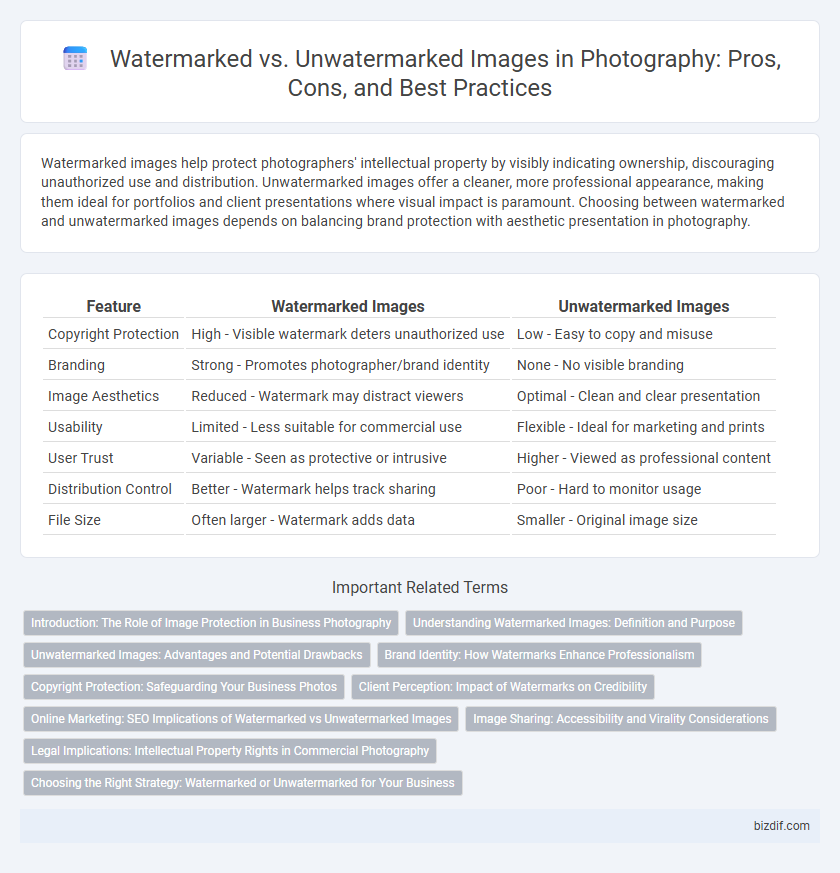Watermarked images help protect photographers' intellectual property by visibly indicating ownership, discouraging unauthorized use and distribution. Unwatermarked images offer a cleaner, more professional appearance, making them ideal for portfolios and client presentations where visual impact is paramount. Choosing between watermarked and unwatermarked images depends on balancing brand protection with aesthetic presentation in photography.
Table of Comparison
| Feature | Watermarked Images | Unwatermarked Images |
|---|---|---|
| Copyright Protection | High - Visible watermark deters unauthorized use | Low - Easy to copy and misuse |
| Branding | Strong - Promotes photographer/brand identity | None - No visible branding |
| Image Aesthetics | Reduced - Watermark may distract viewers | Optimal - Clean and clear presentation |
| Usability | Limited - Less suitable for commercial use | Flexible - Ideal for marketing and prints |
| User Trust | Variable - Seen as protective or intrusive | Higher - Viewed as professional content |
| Distribution Control | Better - Watermark helps track sharing | Poor - Hard to monitor usage |
| File Size | Often larger - Watermark adds data | Smaller - Original image size |
Introduction: The Role of Image Protection in Business Photography
Watermarked images serve as a crucial tool for photographers in safeguarding their intellectual property and preventing unauthorized use in business contexts. Unwatermarked images, while visually clean and appealing, pose significant risks of image theft and unauthorized reproduction, potentially damaging brand integrity and revenue streams. Employing watermarks helps establish ownership and enhances copyright enforcement, playing a vital role in protecting photographers' creative investments in commercial projects.
Understanding Watermarked Images: Definition and Purpose
Watermarked images contain an overlay or logo embedded to signify ownership and protect intellectual property rights in photography. This visible or semi-transparent mark deters unauthorized use and helps photographers maintain control over their work. Understanding the purpose of watermarked images is essential for distinguishing authentic content from copied or unlicensed photos online.
Unwatermarked Images: Advantages and Potential Drawbacks
Unwatermarked images offer a clean, professional appearance that enhances visual appeal and makes them ideal for marketing and presentation purposes. They facilitate seamless integration into various media without distracting overlays, allowing for better viewer focus on the subject. However, the absence of a watermark increases the risk of unauthorized usage and copyright infringement, potentially leading to loss of control over image distribution.
Brand Identity: How Watermarks Enhance Professionalism
Watermarked images serve as a powerful tool for reinforcing brand identity by clearly associating visuals with the photographer's or company's name, thereby enhancing professionalism and credibility. These marks prevent unauthorized use while promoting recognition, making each image an extension of the brand's visual presence. Consistent watermark placement and design contribute to a cohesive portfolio that strengthens trust and distinguishes the brand in a competitive photography market.
Copyright Protection: Safeguarding Your Business Photos
Watermarked images provide a visible layer of copyright protection by clearly indicating ownership, discouraging unauthorized use and theft of business photos. Unwatermarked images are more vulnerable to misuse, as their lack of identifying marks makes it easier for others to claim or distribute the photos without permission. Implementing watermarks strengthens copyright enforcement and helps maintain the integrity and value of professional photography portfolios.
Client Perception: Impact of Watermarks on Credibility
Watermarked images often enhance client perception by signaling professionalism and protecting intellectual property, thereby increasing credibility. However, excessive or distracting watermarks can detract from the visual appeal, potentially undermining trust and engagement. Balancing watermark visibility ensures the image's authenticity is communicated without compromising the viewer's experience.
Online Marketing: SEO Implications of Watermarked vs Unwatermarked Images
Using unwatermarked images in online marketing enhances SEO by improving page load speed and user experience, leading to higher search engine rankings. Watermarked images can detract from visual appeal and may reduce click-through rates, negatively impacting engagement metrics crucial for SEO. Optimizing images with relevant alt text and compression while avoiding intrusive watermarks balances brand protection with SEO effectiveness.
Image Sharing: Accessibility and Virality Considerations
Watermarked images often have reduced accessibility and sharing frequency due to visible branding that can distract viewers and limit aesthetic appeal, impacting virality negatively. Unwatermarked images encourage broader sharing and engagement across social media platforms because they appear more authentic and unobstructed, increasing potential reach and audience interaction. Content creators must balance copyright protection with image accessibility to optimize both brand visibility and viral potential in digital photography communities.
Legal Implications: Intellectual Property Rights in Commercial Photography
Watermarked images serve as a visible deterrent against unauthorized use by clearly indicating ownership, thereby protecting intellectual property rights in commercial photography. Unwatermarked images, when distributed freely, increase the risk of copyright infringement and complicate legal enforcement of ownership claims. Maintaining watermarks can strengthen legal standing during disputes by providing tangible evidence of the photographer's proprietary rights.
Choosing the Right Strategy: Watermarked or Unwatermarked for Your Business
Choosing between watermarked and unwatermarked images depends on your business goals and brand protection needs. Watermarked images deter unauthorized use and promote brand visibility, making them ideal for online portfolios and marketing materials. Unwatermarked images enhance visual appeal and professionalism, better suited for client deliveries and high-quality prints where trust and image clarity are paramount.
Watermarked Images vs Unwatermarked Images Infographic

 bizdif.com
bizdif.com